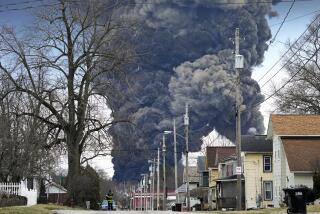Conflicting Rail Signal Claims Weighed
- Share via
CHASE, Md. — Investigators on Tuesday weighed conflicting claims about the operation of signal lights moments before the collision of an Amtrak passenger train and three Conrail engines. Fifteen people were killed and more than 170 were injured in the Sunday wreck.
Meanwhile, Amtrak announced that it had restored limited passenger service past the site of the train crash.
A tower operator told the National Transportation Safety Board that there was a signal on the first of two sets of lights on the Conrail track telling the engineer to slow to 30 m.p.h., Joseph Nall, an NTSB member, said Tuesday night.
Early Tests Cited
Preliminary signal tests on both the Conrail and Amtrak tracks had indicated the signals were operating properly, Nall said.
Nall also disclosed that the NTSB had been told, contrary to its earlier understanding, that alcohol and drug tests were not done on surviving Amtrak crewmen, including a conductor, three assistant conductors and a dispatcher.
The drug test was administered to the tower operator, however, and tissue samples were taken from the deceased Amtrak engineer, Nall said.
The NTSB was told that Amtrak had requested a waiver from the federal regulation requiring toxicological tests, Nall said, adding that the Federal Railroad Administration said it had granted no such request.
The tests could determine such things as “the performance of crewmen after the accident in such things as rescue attempts or supervision of rescue attempts,” he said.
“We wish the tests had been taken. It would aid our investigation. We will not know at this time if there was or was not any alcohol involvement,” he said.
Amtrak said its own tests of the signals, conducted shortly after the wreck, showed they were functioning properly and should have prevented the accident in which a 12-car Amtrak train rammed into the back of three Conrail locomotives.
But sources close to the investigation said Conrail engineer R. L. Gates has reported that the first of the two sets of signals gave him no warning to slow down, and by the time he approached the second--and an indication to stop--it was too late.
The accident occurred as the 12-car passenger train, packed with more than 600 people, rammed the rear of the locomotives as they pulled from a siding onto the main track.
Sources close to the investigation, who refused to be identified, said NTSB officials intend to interview Gates today, and have completed their own independent tests of the signals.
There was no official confirmation, and NTSB spokesman Bill Bush said: “We probably have done most of the work we’ll be doing on the signals out there.”
20 Trains Running
Amtrak spokesman Clifford Black said 20 trains were being permitted to make the run during the day on the busy Northeast Corridor between Washington and New York, rather than the normal 80.
Trains were held to 30 m.p.h. through the area of the wreck, far below the estimated 100 m.p.h. at which the 12-car Colonial was traveling Sunday when it rammed the diesel engines.
More to Read
Sign up for Essential California
The most important California stories and recommendations in your inbox every morning.
You may occasionally receive promotional content from the Los Angeles Times.













